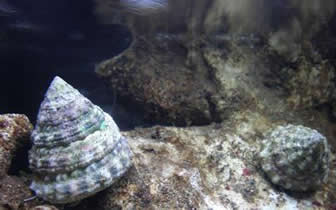Astrea snails
A lot of different Astrea snails, often referred to as turbo snails, are available in the trade and they are probably the most common type of snail kept in aquariums. Astrea snails are easily identified based on the characteristic sharp conical shell circled by a large ridge. Astrea snails can have almost any color from white to purple and orange. The color is often a result of coralline algae growing on the snail but there are also species like the orange turbo snail that have a colorful base color on their shells. Different species grow to different sizes but most species are to be considered fully grown at about 1-2 inch (2.5 - 5 cm). Astrea snails originate from the Caribbean and the Atlantic Ocean.
The price of Astrea snails differs depending on the species but is usually between $1 and $3. They can also be introduced to the aquarium with live rock. These snails have a very hard time turning themselves over if they land on their back and can die if you don't help them by turning them back the right way. They are not very fond of climbing and spend most of their time on the bottom or on not too steep live rock formations.
Astrea snails are an excellent addition to any reef tank and are 100% reef safe. They will not harm any other living creatures and will not disturb the decoration or landscaping. They are very beneficial in any setup as they are good algae eaters and will eat most algae types including hair algae, cyanobacteria and diatoms. Some people think they are rather ineffective against hair algae while others say they are very effective. The difference is probably due to different individuals keeping different species of snail or snails from different populations. There are reports of Astrea snails eating the entire hair algae population and removing the algae from aquariums all together. If the aquarium contains little algae you must supplemented the diet of your snails with other foods, such as dried seaweed rapped around rocks on the bottom of the tank, blanched spinach and lettuce, and vegetable flakes.
Astrea snails are best kept in well established aquariums and are hardy once they have acclimatized themselves to their new surrounding. They are like all snails sensitive towards even small changes in water values and it is therefore important to acclimatize them slowly to a tank using drop acclimatization (allow this process to take at least two hours). They are also sensitive to high nitrate levels and copper. Even small amounts of copper can prove fatal for Astrea snails and copper based medications can not be used in a tank containing Astrea or other snails. They prefera salinity of 1.023 - 1.025, pH 8.1 - 8.4, dKH 8-12, and a temperature of 72 - 78° F / 22-25.5° C. It is important that there is enough calcium in the water if you want your snails to grow optimally and breed. Keeping calcium levels between 350 and 450 ppm is best.
Astrea snail breeding
Astrea snails can be bred in aquaria and they often spawn spontaneously. The eggs are deposited in clusters on a flat surface. They males release their milt directly into the water and the water might become cloudy after an Astrea spawning (as with many other snail species). This is nothing to worry about and the water will clear soon enough. Corals and other filter feeders will eat the particles that make the water cloudy. If you come home and find your aquarium water cloudy and the corals have their polyps extended to filter the water, you can be calm knowing that nothing is wrong. The snails grow fast and need a lot of calcium in the water to grow as they should. An ample food supply increases the chance that you will be able to breed these snails successfully.
Fish News
Aquarium Forum
Calculators
Free Aquarium Ebook
Feedback
Fish Anatomy
Link to us
Photo gallery
Plant species
Tropical fish species
By Common name
By Scientific name
Tropical Marine fish
By Common name
By Scientific name
Algae Control
Aquarium Decoration
Aquarium Resources
Aquatic Plants
Barb Fish
Betta Fish
Breeding Fish
Catfish
Central American Cichlids
Cichlids
Clownfish
Corals
Corydoras Catfish
Discus Fish
Dwarf Cichlids
Fish Diseases
Frogs and Turtles
Goby Fish
Goldfish
Gourami
Invertebrates
Jellyfish
Killiefish
Lake Victoria Cichlids
Livebearers
Malawi Cichlids
Marine Aquariums
Marine Aquarium Fish
Other Fish
Pleco
Predatory Fish
Photography
Pond Fish
Responsible Fish Keeping
Rainbow Fish
Shark Fish
South American Cichlids
Tanganyika Cichlids
Tetra Fish
Tropical Fish Food

